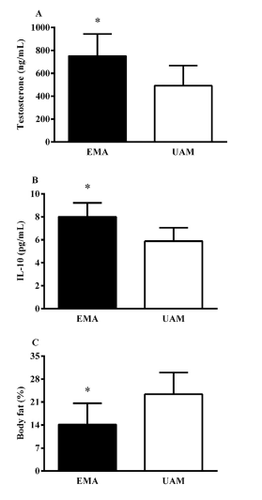-
Home
-
About JCTR
-
Gold Open Access
-
Issues
-
Editorial board
-
Author guidelines
-
Publication fees
-
Online first
-
Special issues
-
News
-
Publication ethics
-
Partners
-
Submit your manuscript
-
Submit your review report
-
Editorial Office
-

This work is licensed under a Creative Commons Attribution-NonCommercial 4.0 International License. ISSN print: 2382-6533 ISSN online: 2424-810X
Volume 7 issue 4
Is lifelong endurance training associated with maintaining levels of testosterone, IL-10, and body fat in middle-aged males?
Sara Duarte Gutierrez*, Samuel da Silva Aguiar, Lucas Pinheiro Barbosa, Patrick Anderson Santos, Larissa Alves Maciel, Patrício Lopes de Araújo Leite, Thiago dos Santos Rosa, Lysleine Alves de Deus, John Eugene Lewis, Herbert Gustavo Simões*
Gutierrez et al. J Clin Transl Res 2021; 7(4):8
Published online: July 16, 2021
Abstract
Background: Aging is associated with a gradual physiological decline, including an imbalance in hormone profile, increased adiposity, and reduced anti-inflammatory cytokines. However, lifelong physical exercise mitigates aging, as observed in endurance-trained middle-aged athletes (EMA).
Aim: We compared and associated testosterone, interleukin 10 (IL-10), and body fat in EMA and untrained age-matched individuals (UAM).
Methods: Participants were EMA (n= 25; 51.48 ± 9.49 years) and UAM (n= 23; 46.0 ± 9.37 years). Both groups underwent body composition measurements (evaluated by a skinfold protocol) and blood sampling for IL-10 (assessed through ELISA® kit) and testosterone (assessed with Roche Diagnostics® kit, Mannheim, Germany, by chemiluminescence technique in a third-party laboratory).
Results: The EMA had lower body fat (14.15 ± 3.82% vs. 23.42 ± 4.95%; p <0.05), higher testosterone (751.68 ± 191.45 ng/dL vs. 493.04 ± 175.15 ng/dL; p <0.05), and higher IL-10 (8.00 ± 1.21 pg/mL vs. 5.89 ± 1.16 pg/mL; p <0.05) when compared to UAM. A significant linear correlation was found between testosterone and IL-10 (r= 0.56; p= 0.001), whereas significant inverse correlations were observed between body fat and testosterone (r= -0.52; p= 0.001), and body fat and IL-10 (r= -0.69; p= 0.001).
Conclusions: EMA had higher levels of IL-10 and testosterone and lower body fat in comparison with UAM. Additionally, higher IL-10 was associated with increased levels of circulating testosterone and lower body fat.
Relevance for patients: The adoption of endurance training as part of a healthy lifestyle may contribute to decreasing age-related testosterone reduction, besides reducing markers of inflammaging, preventing the occurrence of chronic age-related diseases, and thus contributing to healthy aging. For people who already have chronic diseases, physical exercise can shift the immune system toward a more anti-inflammatory profile and, thus, improve their pathological condition. In both cases, physical exercise can help attenuate the decline in testosterone, decrease body fat, and increase anti-inflammatory levels.

DOI: http://dx.doi.org/10.18053/jctres.07.202104.008
Author affiliation
1. Graduate Program in Physical Education, Catholic University of Brasília, DF, Brazil
2. Graduate Program in Medicine, Catholic University of Brasilia, DF, Brazil
3. Department of Physical Education, University Center UDF, DF, Brazil
4. Department of Psychiatry and Behavioral Sciences, Miller School of Medicine, University of Miami, Miami, FL, USA
*Corresponding author
Sara Duarte Gutierrez
Herbert Gustavo Simões
Graduate Program in Physical Education, Catholic University of Brasília, EPTC QS 7 LT 1, Bloco G, Sala G116. Taguatinga, DF, Brazil.
Postal code/CEP: 72.022-900
Tel: +55 (61) 3356 9350
FAX: +55 (61) 3356 9698
Email: saguty@gmail.com
Email: hgsimoes@gmail.com
Handling editor:
Michal Heger
Department of Pharmaceutics, Utrecht University, the Netherlands
Department of Pharmaceutics, Jiaxing University Medical College, Zhejiang, China

